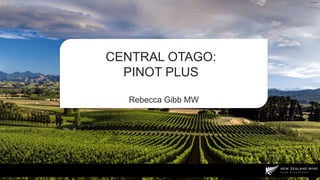Central Otago Masterclass with Rebecca Gibb MW
- 1. CENTRAL OTAGO: PINOT PLUS Rebecca Gibb MW Mt. Beautiful
- 2. REGIONS ? Northland ? Auckland ? Gisborne ? Hawke’s Bay ? Wairarapa ? Nelson ? Marlborough ? Canterbury & North Canterbury ? Waitaki Valley ? Central Otago
- 3. 1,886 TOTAL PRODUCING HECTARES (2017) 11 TOTAL PRODUCTION (000 TONNES, 2018) 3% PROPORTION OF TOTAL NZ PRODUCTION (TONNES, 2018) CENTRAL OTAGO Toi Toi Wines
- 6. Burn Cottage Vineyard Riesling/Grüner Veltliner 2016 Central Otago (Cromwell)
- 7. Carrick Bannockburn Chardonnay 2016 Central Otago (Bannockburn)
- 8. Akitu A1 Pinot Noir 2016 Central Otago (100% Wanaka)
- 9. Amisfield Pinot Noir 2016 Central Otago (Cromwell/Lowburn/Pisa)
- 10. Akarua Pinot Noir 2017 Central Otago (100% Bannockburn)
- 11. Judge Rock Pinot Noir 2016 Central Otago (Alexandra)
- 12. What’s next for Central Otago? Mt. Beautiful
Editor's Notes
- #3: Where is Central Otago 45S Semi continental climate high diurnal temperature differences. Beanie and bikini. Generic harvest reports re NZ no good. Paul Pujol ‘bubble’
- #4: So lots of chatter about Central Pinot since the 2002 vintage. NZ less than 1% of global wine production. It has around 37,000 ha. Central represents abotu 3% of NZ tonnage or 0.03% of world’s wine and yet every year magazine’s cover it.
- #5: Around ? of production is Pinot Noir Believe it or not Central isn’t just PN PG main – talk about who makes good ones and, the climate how it helpS what they’re doing to make it more interesting. Plus Grant Taylor’s We’ll see a Riesling/Gruner Veltliner and a Chardonnay today so we’ll talk more about those styles later
- #6: Location. Milford Sound 6m of rain. Three ranges – the Darran, Humboldt, Richardson Mountains ranges drops its load Queenstown 740mm, Cromwell 437mm, Alexandra 363mm. Irrigation must. Lack of fungal disease. No botrytis. 20% organic Coolness of subregions: Gibbston 910gdd between Mosel and Rheinhessen; Cromwelll 1100GDD (Baden) so what works? Lake Dunstan/Cromwell Basin talk about the subregions or lack thereof.
- #7: Riesling – style: clean lines, purity can vary from dry and lean to sweet but always line of acditiy. Citrus and floral 1.7ha of GV in CO in total - Mt Edward, Quartz Reef, Ata Mara and Burn Cottage Intro Burn Cottage BD Ownership – Marquis Sauvage. Ted Lemon of Littorai Planting trees at top of hill as wind breaks – flowering, evapotransp, close stomata – photosynth stop Blend 52 R/48 GV co-fermented after up to 48 hrs skin contact stainless and old barriques on fine lees
- #8: 10 minute drive from Burn to Carrick. Kawarau River – jetboat Aromatic varieties most common in white dept but Chard 58ha – quarter of what PG. Chard often first to be picked. Easy on oak to give pure epxrsion – also used for Chard/PN sparklers Chard in general in NZ - there’s a move toward more canopy to avoid sunburn – harsh phenolics. Many picking earlier – high acid, lower alcohols, more citrus. Also note understanding of diacetyl – don’t sulphur up the barrels immediately after MLF which fixes it. Whole bunch pressing, 10% new barrels with high solids and indigenous ferment
- #9: Let’s get into Pinots. Go around sub regions but warn them of the rethinking of subregionality In Wanaka not enough critical mass to make generalisation about ‘the style’ Wanaka closest to the Main Divide – cloudiest and wettest of subregions – mellow, restrained . Akitu founded in 2001. 12ha site at altitiude of 380 metres about 7km from Lake Wanaka. 40% whole bunch giving that tension but ripe style (14.6% giving plumpness). 25% new oak
- #10: Story about going on my bicycle Having failed to properly consult map 90ha organically farmed under Pisa range of which 60% PN. Also story about South African viticulturist and Chenin Styles evolved since founded in 1998. Now wild ferment, less harsh extraction not as much cap working although remain on skins for up to 4 weeks. 10% whole bunch; 20% new oak Dark, fleshy, ripe style although brix a bit lower than usual (although 14%!!) Large crop and unstable weather at harvest
- #11: Heading to Bannockburn again – home to Felton, Carrick Big operation for Central Otago with more than 100ha under vine – this is a blend of two of their site in Bannockburn including a vineyard on Felton Road. The 2017s might speak more of the season than the subregion. Cool, windy season with low bunch weights, later harvests. Rest of country got hit by Cyclones Debbie and Cook but this is where bubble came in - hardly any rain. Classic Central fermentation: short preferment, no whole bunhc, 2 punch downs day, 30% new in medium-plus toast. Still 14% abv
- #12: Alexandra sits apart form rest of Central – most easterly, driiest. One producer 15 litres of water per vine every second day. Free draining sandy gravels here Weather reports on tv - Highest maximum temps often in country yet harvests later than around Cromwell Basin. Why? Diurnals massive, particularly in late March and April 2016 – there were 4 nights below zero in March so that’s when you start to worry. Cool spring and early summer but Feb hottest, with persistent winds throughout, low rainfall.
- #13: Concluding A small snapshot of what’s going on in Central Most of vines are now 15-20 years old. Mature vines, mature winemakers and while subregionality may be easier to spot in the wines of Gibbston and Alexandra, 75% of the region’s vines are around Lake Dunstan where climate is largely similar. There are blurred lines when it comes to splitting Central into neat geographical areas – so many variables from within each subregion, then add on to that producer philosophy and crazy different seasons every year and it’s clear that growing diversity is what’s set for Central Otag. Thanks NZ












